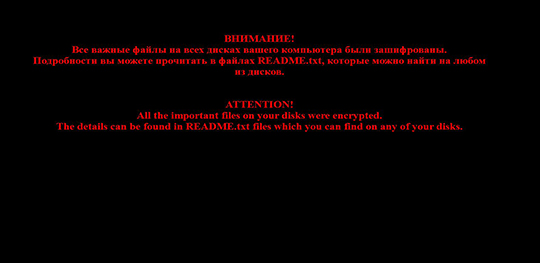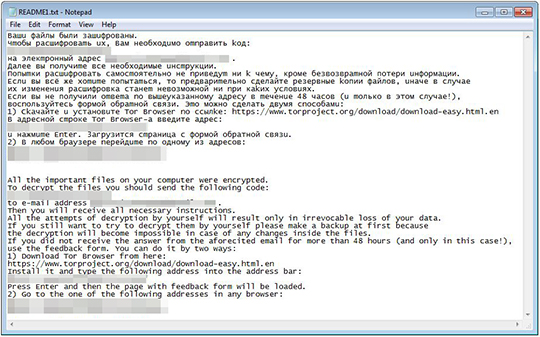Ransom.Win32.CRYPSHED.THGODAI
Trojan-Ransom.Win32.Shade.pyi (Kaspersky), Win32/Filecoder.Shade.A (ESET-NOD32), Ransom:Win32/Troldesh.A (Microsoft)
Windows


Threat Type: Ransomware
Destructiveness: No
Encrypted: Yes
In the wild: Yes
OVERVIEW
This Ransomware arrives on a system as a file dropped by other malware or as a file downloaded unknowingly by users when visiting malicious sites.
It connects to certain websites to send and receive information.
It encrypts files with specific file extensions. It drops files as ransom note.
TECHNICAL DETAILS
Arrival Details
This Ransomware arrives on a system as a file dropped by other malware or as a file downloaded unknowingly by users when visiting malicious sites.
Installation
This Ransomware drops the following copies of itself into the affected system:
- %All Users Profile%\Application Data\Windows\csrss.exe (Windows XP and below)
- %All Users Profile%\Windows\csrss.exe (Windows Vista and above)
(Note: %All Users Profile% is the common user's profile folder, which is usually C:\Documents and Settings\All Users on Windows 2000(32-bit), XP, and Server 2003(32-bit), or C:\ProgramData on Windows Vista, 7, 8, 8.1, 2008(64-bit), 2012(64-bit) and 10(64-bit). )
It drops the following files:
- %User Temp%\{random}\lock
- %User Temp%\{random}\state
- %User Temp%\{random}\unverified-microdesc-consensus
- %User Temp%\{random}\cached-certs
- %User Temp%\{random}\cached-microdesc-consensus
- %User Temp%\{random}\cached-microdescs.new
- %Application Data%\{Random characters}.bmp
(Note: %User Temp% is the current user's Temp folder, which is usually C:\Documents and Settings\{user name}\Local Settings\Temp on Windows 2000(32-bit), XP, and Server 2003(32-bit), or C:\Users\{user name}\AppData\Local\Temp on Windows Vista, 7, 8, 8.1, 2008(64-bit), 2012(64-bit) and 10(64-bit).. %Application Data% is the current user's Application Data folder, which is usually C:\Documents and Settings\{user name}\Application Data on Windows 2000(32-bit), XP, and Server 2003(32-bit), or C:\Users\{user name}\AppData\Roaming on Windows Vista, 7, 8, 8.1, 2008(64-bit), 2012(64-bit) and 10(64-bit).)
It adds the following processes:
- %System%\cmd.exe chcp
- %System%\vssadmin.exe List Shadows
- %System%\vssadmin.exe Delete Shadows /All /Quiet
(Note: %System% is the Windows system folder, where it usually is C:\Windows\System32 on all Windows operating system versions.)
Autostart Technique
This Ransomware adds the following registry entries to enable its automatic execution at every system startup:
HKEY_CURRENT_USER\Software\Microsoft\
Windows\CurrentVersion\Run
Client Server Runtime Subsystem = "%All Users Profile%\Application Data\Windows\csrss.exe (Windows XP and below)"
HKEY_CURRENT_USER\Software\Microsoft\
Windows\CurrentVersion\Run
Client Server Runtime Subsystem = "%All Users Profile%\Windows\csrss.exe (Windows Vista and above)"
Other System Modifications
This Ransomware adds the following registry keys:
HKEY_LOCAL_MACHINE\SOFTWARE\System32\
Configuration
It adds the following registry entries:
HKEY_LOCAL_MACHINE\SOFTWARE\System32\
Configuration
xVersion = "4.0.0.1"
HKEY_LOCAL_MACHINE\SOFTWARE\System32\
Configuration
xpk = "{PUBLIC KEY}"
HKEY_LOCAL_MACHINE\SOFTWARE\System32\
Configuration
xmode = "0"
HKEY_LOCAL_MACHINE\SOFTWARE\System32\
Configuration
xi = "{Random characters}"
HKEY_LOCAL_MACHINE\SOFTWARE\System32\
Configuration
xstate = {number}
HKEY_LOCAL_MACHINE\SOFTWARE\System32\
Configuration
xcnt = "{number}"
HKEY_LOCAL_MACHINE\SOFTWARE\System32\
Configuration
shsnt = "{number}"
HKEY_LOCAL_MACHINE\SOFTWARE\System32\
Configuration
shst = "{number}"
HKEY_LOCAL_MACHINE\SOFTWARE\System32\
Configuration
sh1 = "{number}"
HKEY_LOCAL_MACHINE\SOFTWARE\System32\
Configuration
sh2 = "{number}"
It changes the desktop wallpaper by modifying the following registry entries:
HKEY_CURRENT_USER\Control Panel\Desktop
Wallpaper = %Application Data%\{Random characters}.bmp
It sets the system's desktop wallpaper to the following image:
Other Details
This Ransomware connects to the following URL(s) to get the affected system's IP address:
- http://whatismyipaddress.com/
- http://whatsmyip.net/
It connects to the following website to send and receive information:
- http://{BLOCKED}p2xzclh6fd.onion/{path}
where {path} can be any of the following:- reg.php
- prog.php
- err.php
- cmd.php
- sys.php
- shd.php
- mail.php
Ransomware Routine
This Ransomware encrypts files with the following extensions:
- .1cd
- .3ds
- .3fr
- .3g2
- .3gp
- .7z
- .accda
- .accdb
- .accdc
- .accde
- .accdt
- .accdw
- .adb
- .adp
- .ai
- .ai3
- .ai4
- .ai5
- .ai6
- .ai7
- .ai8
- .anim
- .arw
- .as
- .asa
- .asc
- .ascx
- .asm
- .asmx
- .asp
- .aspx
- .asr
- .asx
- .avi
- .avs
- .backup
- .bak
- .bay
- .bd
- .bin
- .bmp
- .bz2
- .c
- .cbf
- .cdr
- .cer
- .cf
- .cfc
- .cfm
- .cfml
- .cfu
- .chm
- .cin
- .class
- .clx
- .config
- .cpp
- .cr2
- .crt
- .crw
- .crypted
- .cs
- .css
- .csv
- .cub
- .dae
- .dat
- .db
- .dbf
- .dbx
- .dc3
- .dcm
- .dcr
- .der
- .dib
- .dic
- .dif
- .divx
- .djvu
- .dmp
- .dng
- .doc
- .docm
- .docx
- .dot
- .dotm
- .dotx
- .dpx
- .dqy
- .dsn
- .dt
- .dtd
- .dwg
- .dwt
- .dx
- .dxf
- .edml
- .efd
- .elf
- .emf
- .eml
- .emz
- .epf
- .eps
- .epsf
- .epsp
- .erf
- .exr
- .f4v
- .fbk
- .fdb
- .fido
- .fld
- .flm
- .flv
- .frm
- .fxg
- .geo
- .gif
- .grs
- .gz
- .h
- .hdr
- .hpp
- .hta
- .htc
- .htm
- .html
- .icb
- .ics
- .iff
- .inc
- .indd
- .ini
- .iqy
- .j2c
- .j2k
- .java
- .jp2
- .jpc
- .jpe
- .jpeg
- .jpf
- .jpg
- .jpx
- .js
- .jsf
- .json
- .jsp
- .kdc
- .kmz
- .kwm
- .lasso
- .lbi
- .lgf
- .lgp
- .log
- .lst
- .m1v
- .m4a
- .m4v
- .max
- .md
- .mda
- .mdb
- .mde
- .mdf
- .mdw
- .mef
- .mft
- .mfw
- .mht
- .mhtml
- .mka
- .mkidx
- .mkv
- .mos
- .mov
- .mp3
- .mp4
- .mpeg
- .mpg
- .mpv
- .mrw
- .msg
- .mtr
- .mxl
- .myd
- .myi
- .nef
- .nrw
- .obj
- .odb
- .odc
- .odm
- .odp
- .ods
- .oft
- .one
- .onepkg
- .onetoc2
- .opt
- .oqy
- .orf
- .p12
- .p7b
- .p7c
- .pam
- .pbm
- .pct
- .pcx
- .pdd
- .pdp
- .pef
- .pem
- .pff
- .pfm
- .pfx
- .pgm
- .php
- .php3
- .php4
- .php5
- .phtml
- .pict
- .pl
- .pls
- .pm
- .png
- .pnm
- .pot
- .potm
- .potx
- .ppa
- .ppam
- .ppm
- .pps
- .ppsm
- .ppt
- .pptm
- .pptx
- .prn
- .ps
- .psb
- .psd
- .pst
- .ptx
- .pub
- .pwm
- .pxr
- .py
- .qt
- .r3d
- .raf
- .rar
- .raw
- .rdf
- .rgbe
- .rle
- .rqy
- .rss
- .rtf
- .rw2
- .rwl
- .safe
- .sct
- .sdpx
- .shtm
- .shtml
- .slk
- .sln
- .sql
- .sr2
- .srf
- .srw
- .ssi
- .st
- .stm
- .svg
- .svgz
- .swf
- .tab
- .tar
- .tbb
- .tbi
- .tbk
- .tdi
- .tga
- .thmx
- .tib
- .tif
- .tiff
- .tld
- .torrent
- .tpl
- .txt
- .u3d
- .udl
- .uxdc
- .vault
- .vb
- .vbk
- .vbm
- .vbs
- .vcs
- .vda
- .vdr
- .vdw
- .vdx
- .vhd
- .vib
- .vrp
- .vsd
- .vss
- .vst
- .vsw
- .vsx
- .vtm
- .vtml
- .vtx
- .wav
- .wb2
- .wbm
- .wbmp
- .wim
- .wmf
- .wml
- .wmv
- .wpd
- .wps
- .x3f
- .xl
- .xla
- .xlam
- .xlk
- .xlm
- .xls
- .xlsb
- .xlsm
- .xlsx
- .xlt
- .xltm
- .xltx
- .xlw
- .xml
- .xps
- .xsd
- .xsf
- .xsl
- .xslt
- .xsn
- .xtp
- .xtp2
- .xyze
- .xz
- .zip
It avoids encrypting files with the following strings in their file name:
- desktop.ini
- boot.ini
- Bootfont.bin
- ntuser.ini
- NTUSER.DAT
- IconCache.db
It renames encrypted files using the following names:
- {random characters}.{ID}.crypted000007
It drops the following file(s) as ransom note:
- {Drive letter}:\README{1-10}.txt
- %Desktop%\README{1-10}.txt
(Note: %Desktop% is the current user's desktop, which is usually C:\Documents and Settings\{User Name}\Desktop on Windows 2000(32-bit), XP, and Server 2003(32-bit), or C:\Users\{user name}\Desktop on Windows Vista, 7, 8, 8.1, 2008(64-bit), 2012(64-bit) and 10(64-bit).)
It leaves text files that serve as ransom notes containing the following text:
SOLUTION
Step 1
Before doing any scans, Windows 7, Windows 8, Windows 8.1, and Windows 10 users must disable System Restore to allow full scanning of their computers.
Step 2
Note that not all files, folders, and registry keys and entries are installed on your computer during this malware's/spyware's/grayware's execution. This may be due to incomplete installation or other operating system conditions. If you do not find the same files/folders/registry information, please proceed to the next step.
Step 3
Restart in Safe Mode
Step 4
Delete this registry key
Important: Editing the Windows Registry incorrectly can lead to irreversible system malfunction. Please do this step only if you know how or you can ask assistance from your system administrator. Else, check this Microsoft article first before modifying your computer's registry.
- In HKEY_LOCAL_MACHINE\SOFTWARE\System32
- Configuration
- Configuration
Step 5
Delete this registry value
Important: Editing the Windows Registry incorrectly can lead to irreversible system malfunction. Please do this step only if you know how or you can ask assistance from your system administrator. Else, check this Microsoft article first before modifying your computer's registry.
- In HKEY_CURRENT_USER\Software\Microsoft\Windows\CurrentVersion\Run
- Client Server Runtime Subsystem = "%All Users Profile%\Application Data\Windows\csrss.exe (Windows XP and below)"
- Client Server Runtime Subsystem = "%All Users Profile%\Application Data\Windows\csrss.exe (Windows XP and below)"
- In HKEY_CURRENT_USER\Software\Microsoft\Windows\CurrentVersion\Run
- Client Server Runtime Subsystem = "%All Users Profile%\Windows\csrss.exe (Windows Vista and above)"
- Client Server Runtime Subsystem = "%All Users Profile%\Windows\csrss.exe (Windows Vista and above)"
Step 6
Search and delete these files
- %User Temp%\{random}\lock
- %User Temp%\{random}\state
- %User Temp%\{random}\unverified-microdesc-consensus
- %User Temp%\{random}\cached-certs
- %User Temp%\{random}\cached-microdesc-consensus
- %User Temp%\{random}\cached-microdescs.new
- %Application Data%\{Random characters}.bmp
- {Drive letter}:\README{1-10}.txt
- %Desktop%\README{1-10}.txt
Step 7
Restart in normal mode and scan your computer with your Trend Micro product for files detected as Ransom.Win32.CRYPSHED.THGODAI. If the detected files have already been cleaned, deleted, or quarantined by your Trend Micro product, no further step is required. You may opt to simply delete the quarantined files. Please check this Knowledge Base page for more information.
Step 8
Restore encrypted files from backup.
Step 9
Reset your Desktop properties
Step 10
Scan your computer with your Trend Micro product to delete files detected as Ransom.Win32.CRYPSHED.THGODAI. If the detected files have already been cleaned, deleted, or quarantined by your Trend Micro product, no further step is required. You may opt to simply delete the quarantined files. Please check the following Trend Micro Support pages for more information:
Did this description help? Tell us how we did.



